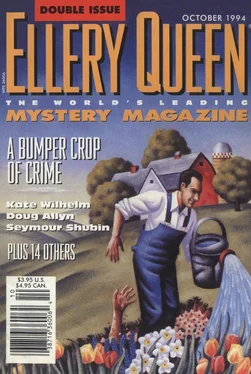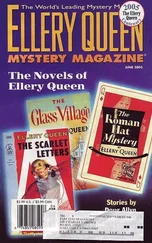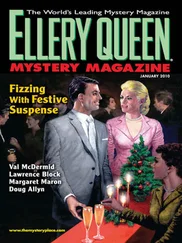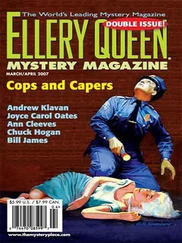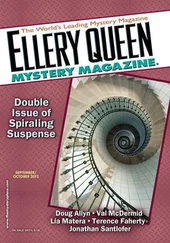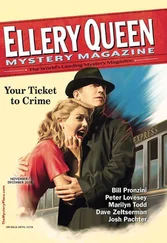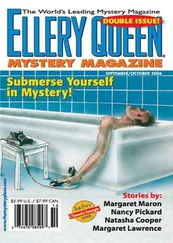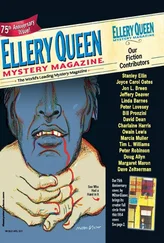Doug Allyn - Ellery Queen’s Mystery Magazine. Vol. 104, No. 4 & 5. Whole No. 633 & 634, October 1994
Здесь есть возможность читать онлайн «Doug Allyn - Ellery Queen’s Mystery Magazine. Vol. 104, No. 4 & 5. Whole No. 633 & 634, October 1994» весь текст электронной книги совершенно бесплатно (целиком полную версию без сокращений). В некоторых случаях можно слушать аудио, скачать через торрент в формате fb2 и присутствует краткое содержание. Город: New York, Год выпуска: 1994, ISBN: 1994, Издательство: Dell Magazines, Жанр: Детектив, на английском языке. Описание произведения, (предисловие) а так же отзывы посетителей доступны на портале библиотеки ЛибКат.
- Название:Ellery Queen’s Mystery Magazine. Vol. 104, No. 4 & 5. Whole No. 633 & 634, October 1994
- Автор:
- Издательство:Dell Magazines
- Жанр:
- Год:1994
- Город:New York
- ISBN:ISSN 1054-8122
- Рейтинг книги:4 / 5. Голосов: 1
-
Избранное:Добавить в избранное
- Отзывы:
-
Ваша оценка:
- 80
- 1
- 2
- 3
- 4
- 5
Ellery Queen’s Mystery Magazine. Vol. 104, No. 4 & 5. Whole No. 633 & 634, October 1994: краткое содержание, описание и аннотация
Предлагаем к чтению аннотацию, описание, краткое содержание или предисловие (зависит от того, что написал сам автор книги «Ellery Queen’s Mystery Magazine. Vol. 104, No. 4 & 5. Whole No. 633 & 634, October 1994»). Если вы не нашли необходимую информацию о книге — напишите в комментариях, мы постараемся отыскать её.
Ellery Queen’s Mystery Magazine. Vol. 104, No. 4 & 5. Whole No. 633 & 634, October 1994 — читать онлайн бесплатно полную книгу (весь текст) целиком
Ниже представлен текст книги, разбитый по страницам. Система сохранения места последней прочитанной страницы, позволяет с удобством читать онлайн бесплатно книгу «Ellery Queen’s Mystery Magazine. Vol. 104, No. 4 & 5. Whole No. 633 & 634, October 1994», без необходимости каждый раз заново искать на чём Вы остановились. Поставьте закладку, и сможете в любой момент перейти на страницу, на которой закончили чтение.
Интервал:
Закладка:
“That’s the husband?” asked Simon. They looked towards number eighteen, which had a shut-up look and had evinced no sign of life since Simon arrived for work. “I’ve only seen them, you see, from here. I thought he was some kind of lodger.”
“Oh no. He’s the husband. Presents a programme on Radio Two — The Heartbreak Hour. He’s got a nice taste in music. I’ve listened to it now and then when I’m on obbo. They could write tunes in those days. Reckon he’ll have had enough of heartbreak when all this is over, though.”
“What about the other bloke — the City gent?”
“The wife’s brother. He’s no City gent. Got a record in three continents. He’d hardly washed the blood off himself when we arrived. There were still traces in the bathroom basin.”
“You mean — he tried to kill the one I caught?”
“Of course. You didn’t catch him, you saved him.”
“Why?”
“Good question. He says his sister put him up to it — wanted shot of her husband. Don’t believe a word of it myself. She’s a dupe if ever there was one. I think he was after his collection.”
“Collection?”
“Fifties memorabilia of the rock stars. Casefuls of it in the attic. Could fetch a bomb in an auction.”
“I did hear something a week or two back, when I was going past their window,” Simon said, and told him what he had heard. “I think you’re right. I don’t think she wanted it done.”
“ Ve-ry nice,” said the inspector appreciatively. “You’re a sharp lad. I like someone who observes the facts. We’ll be needing you at the trial.”
When he had gone Simon bent over his wall, almost blushing. Sharp, indeed! He’d made a total fool of himself. It took him a while to cool down. The regular motion of placing the bricks, slapping on concrete, then placing another brick on top helped him, calmed him down. He was conscious that over the last few weeks he had come to enjoy the job he was doing. It was not mindless at all, but satisfying, an aesthetic experience. And it made you aware of other buildings — the shape, the size, the feel of them — all built by people like himself. He could certainly get interested in buildings. There was something about them that was solid, unchanging, definite. Something un human.
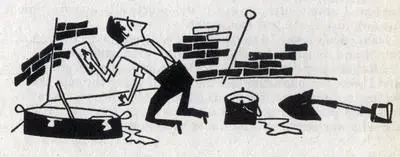
The Corpse in the Attic
by Gunnar Staalesen
© 1994 by Gunnar Staalesen
EQMM has a long tradition of searching out mystery writers from other parts of the world. During the thirteen years in which EQMM’s founder Fred Dannay held his worldwide mystery short-story contests, submissions poured in from six continents and more countries than we can list here. This month we introduce an author known and respected in his native country of Sweden, but previously unpublished in the United States. Gunnar Staalesen is primarily a writer of crime novels, but he has had several of his small collection of short stories translated for EQMM. We begin with a piece that he describes as having a Roald Dahl-like atmosphere...
The air up in the attic was stuffy and stale, the way it usually is in such places; a smell of moth-eaten old clothes, yellowed, dusty books, cardboard boxes from the 1950s tied up with fraying twine, and big empty suitcases made of fiberboard. If they were empty, that is.
“Good God, Karl!” gasped Edvard when he got to the top of the steep attic ladder. “Why don’t we just take it all straight to the dump?” He ran his hand through his gray-streaked hair, and in the dim light of the attic I saw even more clearly how lined his face had become. I gave a little shiver. It was practically a mirror image of my own face that I was looking at.
“Oh, I don’t know,” I said. “I think we ought to go through it. We might find something... that we think we ought to keep.”
After our parents died within a few months of each other, Edvard and I were the ones who had the task of going through the house; sorting out the most important papers; collecting photographs, letters, and other things we wanted to save; dividing up what we thought was worth dividing; and then getting rid of all the rest, either by selling it or, as Edvard so aptly put it, by taking it “straight to the dump.”
Big houses like this seem even bigger on such occasions. The dressers suddenly have more drawers and the cupboards more shelves. You find little desks and old wardrobes in places you never remember seeing any, but then it was a good many years ago that the two of us had left home. After Dad retired, our parents lived a quiet and peaceful life, and aside from the house and the property it was on, they hadn’t really accumulated much of value, so it was a relatively simple inheritance to divide up. We wound up staying friends afterwards, too.
The old house was situated behind the autumn colors of high hedges, on a slight incline. On the neighboring lots there were other old tumbledown castles — and here and there a new house where someone had bought part of a lot that was big enough for two. It had been a quiet neighborhood to grow up in, with big yards and plenty of places to play. In many ways it was a sheltered environment, and we could only remember one great tragedy...
We had spent several days going through the house from the cellar all the way up to the top floor, and at the end of each day we felt dusty and grimy. It was with great reluctance that we set up the ladder and climbed up into the attic. The trapdoor was hard to budge, and we had to brace our backs against it to lift it open. The light switch hung on a loose cord from the roof, and when we turned on the light, we stood there blinking our eyes.
“I really don’t remember it being this big,” said Edvard, looking around in despair.
“I don’t either,” I replied, hearing the surprise in my own voice.
We hadn’t spent much time up here either. Because of the steep ladder and the risk of accidents, our parents had forbidden us to come up here alone; so it was only in their company — plus a couple of perilous expeditions when we had been home alone — that we had ever been up here. The naked bulb below the roof cast a distorted light over the room, giving the boxes and suitcases peculiar contours and sketching odd shadows up across the slanting walls.
“It certainly could use airing out,” said Edvard, wrinkling his nose.
I nodded in silence, glumly moving the nearest box. There was nothing to do but get started.
Several hours later we had worked our way over to the wall, deep inside the attic and as far away as possible from the trapdoor. The light from the bulb below the roof barely reached that far, so we had turned on a flashlight, which lay there lighting up the floor next to us.
Against the wall stood an iron-studded wooden trunk.
“Do you remember this?” asked Edvard.
“No.” I shook my head. “It must have been up here from before I can remember.”
We glanced behind us. We hadn’t found much that was worth keeping. Almost everything was stacked up in a comer of the attic so the moving company could deal with it when they took over. A few personal belongings, some old photo albums, and a handful of books were gathered over by the trapdoor. The old trunk was the only thing that remained.
Edvard bent down. “It’s locked,” he said as he tried to budge the lid.
“It is?” I stared at the keyhole. It was empty.
I bent down next to him and gripped the heavy, well-constructed lid. It was impossible to get it open.
Читать дальшеИнтервал:
Закладка:
Похожие книги на «Ellery Queen’s Mystery Magazine. Vol. 104, No. 4 & 5. Whole No. 633 & 634, October 1994»
Представляем Вашему вниманию похожие книги на «Ellery Queen’s Mystery Magazine. Vol. 104, No. 4 & 5. Whole No. 633 & 634, October 1994» списком для выбора. Мы отобрали схожую по названию и смыслу литературу в надежде предоставить читателям больше вариантов отыскать новые, интересные, ещё непрочитанные произведения.
Обсуждение, отзывы о книге «Ellery Queen’s Mystery Magazine. Vol. 104, No. 4 & 5. Whole No. 633 & 634, October 1994» и просто собственные мнения читателей. Оставьте ваши комментарии, напишите, что Вы думаете о произведении, его смысле или главных героях. Укажите что конкретно понравилось, а что нет, и почему Вы так считаете.
